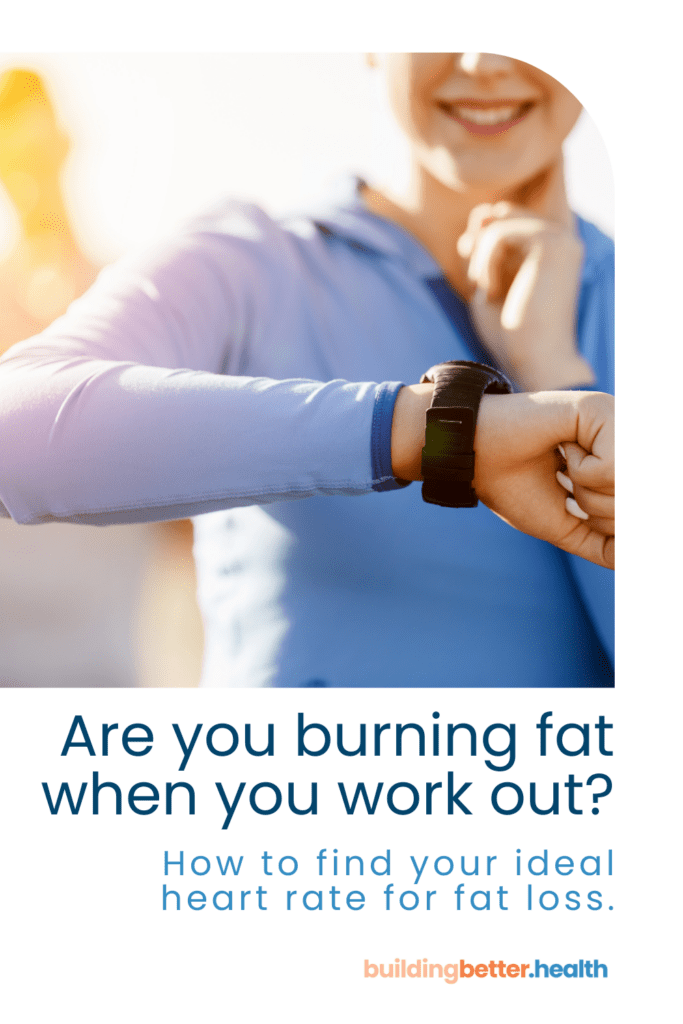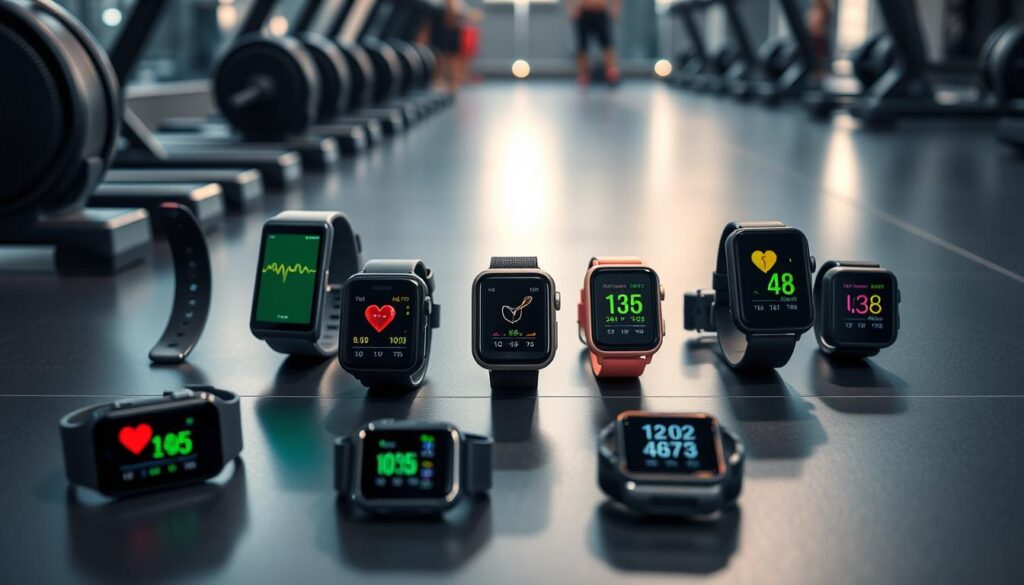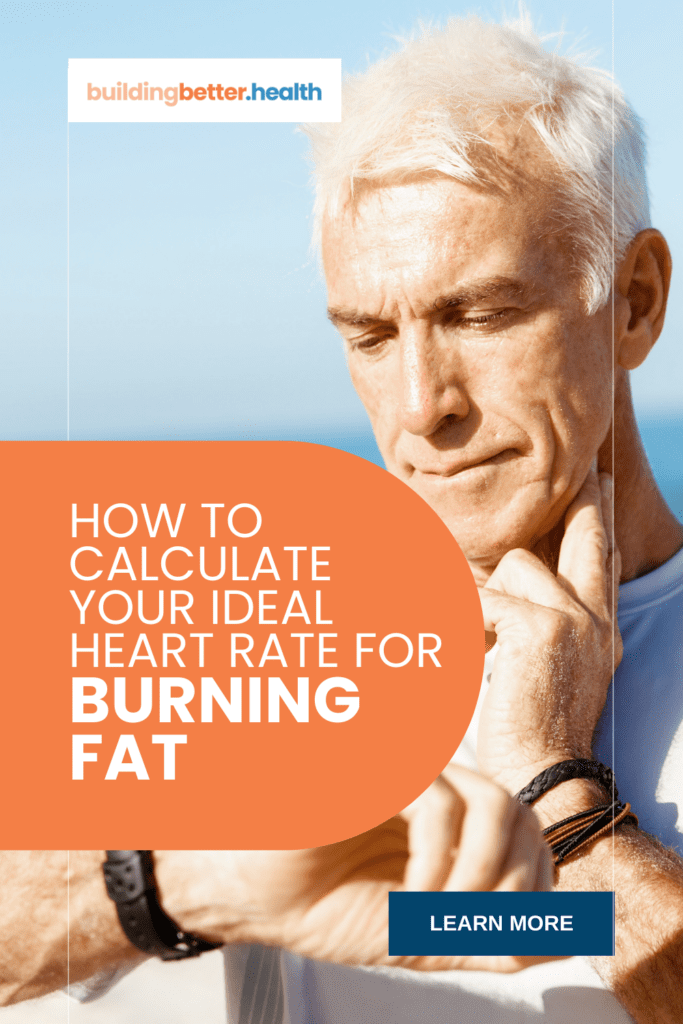
Please note: This website contains affiliate links. As an Amazon Associate, we earn from qualifying purchases at no additional cost to you.
Ready to lose a few pounds in the new year?
Understanding the fat-burning heart rate is key to losing weight. When you work out in your optimal zone, your body uses fat for energy more than sugars and carbs12. This makes your workouts more effective for losing fat and improving your body shape.
The fat-burning heart rate is between 60-80% of your maximum heart rate12. Knowing how to find your fat-burning zone helps you get the most out of your workouts. It’s a great way to lose weight effectively.
We’ll Cover:
- The Fundamentals of Your Fat-Burning Heart Rate
- How to Calculate Your Maximum Heart Rate
- Find Your Optimal Fat Burning Heart Rate Zone
- Overview of Target Heart Rates
- Tools to Monitor Your Heart Rate During Exercise
- Best Exercises
- Common Mistakes to Avoid

Understanding Fat Burning Heart Rate Fundamentals
Monitoring your heart rate is key to burning fat during workouts. The fat-burning zone is between 60-80% of your max heart rate. This is where your body uses fat for energy3. It’s called the “fat-burning zone” and is vital for those wanting to lose weight through exercise.
What Happens to Your Body in the Fat Burning Zone
In this zone, your body changes how it uses energy. It starts to use fat as the main fuel, not carbs. This shift is crucial for losing fat during exercise3.
The Science Behind Fat Oxidation
Fat oxidation is a proven science. When you exercise at a moderate pace, your body uses fat for energy. This is different from high-intensity workouts, where carbs are used more3.
Why Heart Rate Matters for Weight Loss
Heart rate shows how hard you’re working out and affects weight loss. Staying in the fat-burning zone means your body burns fat during your workout. This focused approach can lead to better and lasting weight loss3.
| Formula | Description |
|---|---|
| Fox Formula | MAX HR = 220 – age (Underestimation by up to 40 BPM, less accurate with increasing age)4 |
| Gulati Formula | MAX HR for women = 206 – (0.88 x age) (Developed in 2010, designed for better accuracy in women)4 |
| HUNT Fitness Study Formula | MAX HR = 211 – (0.64 x age) (Based on a study of 3,320 healthy adults, more accurate than the Fox formula)4 |
| Tanaka Formula | MAX HR = 208 – (0.7 x age) (Considered more reliable than the Fox formula)4 |
These formulas help find your max heart rate. This is key for finding your fat-burning heart rate zone4.
“Regardless of the heart rate zone, fat and calories are burned during exercise. The fat-burning heart rate is considered limited, and people burn fat and calories regardless of their heart rate when engaging in physical activity.”3
Remember, the fat-burning heart rate zone is just one part of losing weight. It’s important to work with a fitness expert or doctor. They can create a workout plan that fits your fitness level, age, and more3.
How to Calculate Your Maximum Heart Rate
Finding your maximum heart rate is key to burning fat effectively. Use a simple formula: subtract your age from 2205. For instance, if you’re 35, your maximum heart rate is 185 beats per minute (bpm).
The fat-burning heart rate zone is between 64% to 76% of your maximum heart rate5. For a 40-year-old, this means keeping your heart rate between 115 bpm and 137 bpm during exercise5. To find the lower end, multiply your maximum heart rate by 0.64. For the higher end, multiply by 0.765.
The Fox formula is another way to find your maximum heart rate: 220 minus your age5. Maximum heart rates vary by age, from 200 bpm at 20 to 150 bpm at 705. This results in fat-burning zones from 96–152 bpm for those aged 20 to 705.
Knowing how to calculate your maximum heart rate and fat-burning zone is crucial. It helps you optimize your workouts for fat loss6. Use tools like treadmills and wearable devices to keep your heart rate in the fat-burning zone5.
Finding Your Optimal Fat Burning Heart Rate Zone
To burn fat effectively during workouts, finding your optimal heart rate zone is key. This zone is between 60-80% of your maximum heart rate7. Working out in this range helps your body use fat for energy, aiding in weight loss7.
The 60-80% Rule for Fat Burning
The 60-80% rule is the best heart rate range for burning fat7. Staying in this zone lets your body use fat efficiently. This leads to better fat burning and weight loss7.
Age-Specific Calculations
Your age affects your fat burning heart rate zone. As you age, your maximum heart rate goes down. This changes your fat burning range3. For example, by 40, your range is 90 to 126 beats per minute3.
Individual Factors Affecting Your Zone
While the 60-80% rule and age calculations are helpful, your zone can also vary. Your fitness level, medication, and health can change how you respond to exercise. A fitness professional can help find your unique zone for better results3.

| Heart Rate Zone | Intensity Level | Calorie Burn | Fat Burn |
|---|---|---|---|
| Warm-up (60-70%) | Moderate | Moderate | Moderate |
| Fat Burning (70-80%) | Vigorous | High | High |
| Aerobic (81-93%) | Intense | Very High | Low |
| Anaerobic (94-100%) | Maximal | Extremely High | Minimal |
Understanding the 60-80% rule, age-specific calculations, and individual factors helps optimize your workouts. This way, you can reach your weight loss goals738.
Target Heart Rate Zones Explained
Understanding your target heart rate zones is key for weight loss. Heart rate zones are based on a percentage of your maximum heart rate91011. There are five zones, with Zone 1 burning about 85% fat and Zone 5 being the most intense9. The fat-burning zone is between 50% to 72% of your VO2 max10.
Your resting heart rate is important for finding your target zones. It usually ranges from 60 to 100 beats per minute911. To find your maximum heart rate, subtract your age from 2201011. This helps calculate the different intensity levels, from low (50-70% MHR) to maximum (90-100% MHR)10.
Trainers suggest working out in Zones 1 to 3 for weight loss and building endurance. These zones use more fat for energy9. Strength-training also helps with fat loss by increasing your metabolic rate9. By knowing your target heart rate zones and mixing up your workouts, you can lose fat more effectively10.
| Heart Rate Zone | Percentage of Maximum Heart Rate | Recommended Use |
|---|---|---|
| Zone 1 | 50-60% | Warm-up, recovery, and active rest |
| Zone 2 | 60-70% | Fat-burning and endurance training |
| Zone 3 | 70-80% | Cardiovascular and aerobic conditioning |
| Zone 4 | 80-90% | Anaerobic and high-intensity interval training |
| Zone 5 | 90-100% | Maximum effort and sprint training |
Knowing your target heart rate zones and mixing up your workouts can help you lose weight effectively. Remember, heart rate for weight loss is just one part. A balanced approach that includes strength training, proper nutrition, and lifestyle factors is also key for lasting weight management.
Methods + Tools to Monitor Your Heart Rate During Exercise
Tracking your heart rate during exercise is key to reaching your fitness goals. Whether you’re aiming for weight loss, better endurance, or heart health, there are many tools and methods to help. These tools make it easier to keep an eye on your heart rate12.
Traditional Pulse Checking
The simplest way to check your heart rate is by feeling your pulse. Place your fingers on your wrist or neck to count beats per minute. This method gives a quick heart rate check but might not work well during hard workouts13.
Digital Heart Rate Monitors
Digital heart rate monitors are a better choice for accurate tracking. These devices, worn on the chest or wrist, use sensors to show your heart rate in real-time. They offer a precise and easy way to monitor your heart rate during exercise13.
Smartwatch and Fitness Tracker Options
Smartwatches and fitness trackers have made tracking heart rate easy. They use sensors to track your heart rate continuously. Many of these devices also connect with apps, giving you detailed insights to improve your workouts13.
Choosing the right method to monitor your heart rate can help you reach your fitness goals. Whether it’s for burning fat, improving endurance, or heart health, tracking your heart rate is essential.
Best Selling Heart Rate Monitors
We curated a list of the best selling monitors on Amazon – check it out here!

| Method | Advantages | Disadvantages |
|---|---|---|
| Traditional Pulse Checking |
|
|
| Digital Heart Rate Monitors |
|
|
| Smartwatch and Fitness Tracker Options |
|
|
The best method for monitoring your heart rate depends on your preferences, budget, and workout type. Think about the pros and cons of each option to find what suits your fitness needs13.
Best Exercises for Fat Burning Heart Rate Training
To lose fat effectively, it’s important to hit the right heart rate zone. Activities like slow jogging, brisk walking, and water aerobics are great15. Cycling at under 10 miles per hour, doubles tennis, and ballroom dancing also work well15. It’s key to watch your heart rate to see what suits you best.
The talk test is a good way to check if you’re in the fat-burning zone. If you can talk but are a bit breathless, you’re likely there.
For the best fat burning, exercise at a level that’s challenging but still comfortable15. The American Council on Exercise says exercising at a lower effort helps burn fat for energy15. Mixing cardio with strength training is best, as it helps burn more fat even when you’re not moving15.
- Slow jogging
- Brisk walking
- Water aerobics
- Cycling under 10 miles per hour
- Doubles tennis
- Ballroom dancing
To stay in the fat-burning zone, aim for a heart rate between 60 and 90 percent of your max15. This is about 220 minus your age. Staying in this zone can help you lose more fat over time.
It’s all about finding fun activities that keep you in your heart rate zone. By doing so, you’ll be on your way to reaching your weight loss goals.
Common Mistakes to Avoid When Training in Fat Burning Zone
Getting the most out of your workouts is key for losing weight. It’s important to watch your heart rate and how hard you’re working. This ensures you’re in the right zone for burning fat16.
Intensity Level Errors
One big mistake is working out too hard or too easy. If you’re too high, you’ll burn carbs instead of fat17. On the other hand, being too low means you’re not pushing your body enough to burn fat17.
Duration Misconceptions
Many think longer cardio sessions are best for losing fat. But studies show high-intensity interval training (HIIT) works better17. Mixing both types of workouts can lead to better fat burning results.
Recovery Period Mistakes
Not giving your body enough rest is another mistake. Rest is key for keeping your heart rate in check and avoiding injuries17. Finding the right balance between work and rest is crucial for fat loss.
Avoid these mistakes and focus on the right heart rate range. This will help you lose weight and stay healthy1617.
The Relationship Between Heart Rate and Calorie Burn
When trying to lose weight, understanding how heart rate and calorie burn work together is key. Lower-intensity workouts in the fat-burning zone might burn more fat. Yet, higher-intensity exercises burn more total calories3. This is because how much you burn calories changes based on your age, weight, and fitness level3.
The fat-burning zone is around 60-80% of your maximum heart rate. It’s the best range for burning fat calories37. But, you might not burn the most calories here. High-intensity workouts, at 70-85% of your maximum heart rate, burn more calories during and after exercise7.
Finding the right balance between heart rate and calorie burn is important. For weight loss, high-intensity workouts are better. They use up glycogen and force your body to use fat for energy7. For endurance or performance, the fat-burning zone is better. It lets you work out longer7.
| Heart Rate Zone | Intensity Level | Percentage of Maximum Heart Rate | Primary Fuel Source |
|---|---|---|---|
| Fat Burning Zone | Moderate | 50% – 70% | Fat |
| Aerobic Zone | Vigorous | 81% – 93% | Carbohydrates |
| Anaerobic Zone | High | 94% – 100% | Carbohydrates |
It’s important to find an exercise routine that fits your goals and fitness level. Talking to a healthcare professional can help you find the right heart rate zones and exercise intensities for your goals3.
“People will burn calories and fat regardless of their heart rate when exercising.”7
Optimizing Your Workout Schedule for Fat Loss
To lose fat, mix exercises in the best target heart rate zone for weight loss with intense workouts. Interval training, which switches between moderate and high-intensity, boosts fat loss and heart health. Aim for at least 150 minutes of moderate exercise weekly.
The fat burning heart rate chart is a good guide, but remember, it varies by age, fitness, and personal taste. A balanced plan that includes diet, sleep, and stress control is key for lasting fat loss.
Blend low-intensity, fat-burning workouts with high-intensity ones to boost your routine’s effectiveness. The goal is to stick to a plan you can keep up with. Long-term habits are the secret to lasting success.
You’ve got this!

More Building Better Health Articles You Might Like
Walk Your Way to Weight Loss | A Daily Steps Guide
Essential Home Gym Equipment for Small Spaces
Other Popular Resources for Fat Burning Heart Rate
-
- Fat Burning Zone Calculator – https://www.omnicalculator.com/sports/fat-burning-zone
- Fat-Burning Heart Rate: What is It, How to Calculate, and Chart by Age – https://www.healthline.com/health/fitness-exercise/fat-burning-heart-rate
- Fat burning heart rate: Definition, chart, and effectiveness – https://www.medicalnewstoday.com/articles/326002
- Fat Burning Heart Rate: Definition And Chart – https://www.forbes.com/health/wellness/fat-burning-heart-rate/
- The Truth of the Fat Burning Zone: What is the Best Heart Rate to Lose Fat? – https://www.mountelizabeth.com.sg/health-plus/article/fat-burning-zone-heart-rate-to-lose-fat
- How To Calculate Heart Rate Zones – https://health.clevelandclinic.org/exercise-heart-rate-zones-explained
- What to Know: Heart Rate for Fat-Burning Vs. Cardio – https://www.webmd.com/fitness-exercise/what-to-know-heart-rate-fat-burning-cardio
- Your Expert Guide to Target Heart Rate and Weight Loss – https://www.weightwatchers.com/us/blog/fitness/target-heart-rate-weight-loss?srsltid=AfmBOoovN0-BY_jmScgJBE6EAZQBo7R4RRjQ85obpBmzXlV9_9ZhU6R4
This website contains affiliate links. As an Amazon Associate, we earn from qualifying purchases..
Please note: This website contains affiliate links. As an Amazon Associate, we earn from qualifying purchases at no additional cost to you.










